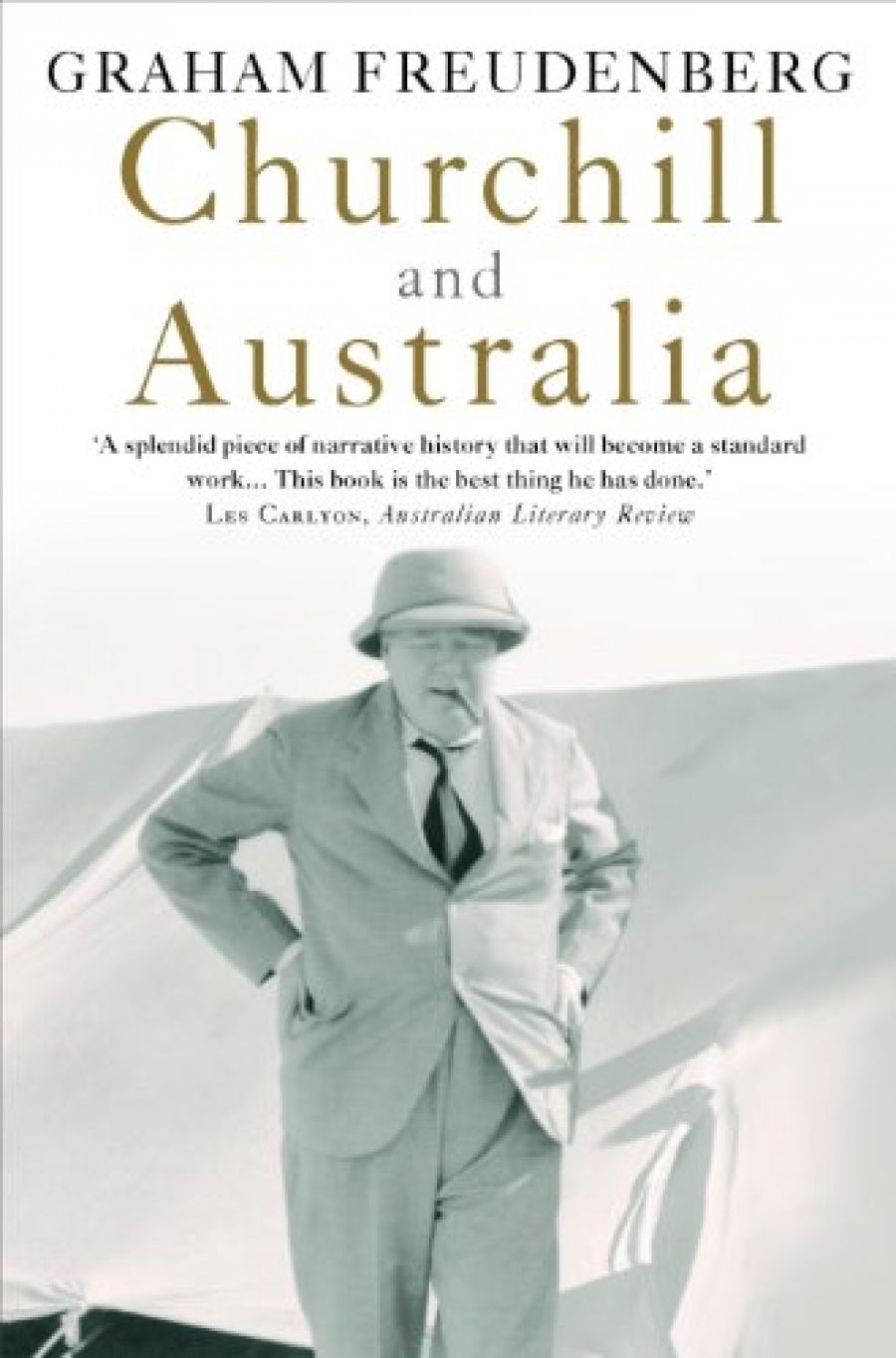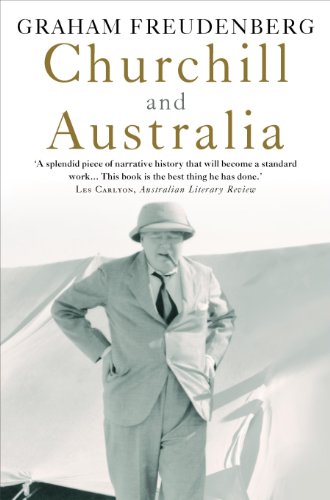
- Free Article: No
- Contents Category: History
- Review Article: Yes
- Article Title: The Winston factor
- Online Only: No
- Custom Highlight Text:
It was a bright and bold idea of Graham Freudenberg to write a book on Winston Churchill and his long links with Australian political and military life. Though Churchill didn’t visit Australia – ‘wise man’, some said – he was a strong or even decisive influence at several turning points in our history and indeed our mythology.
Churchill exerted influence here long before 1940, when he became Britain’s prime minister. He sparred with Alfred Deakin in London in 1907; he was the political mastermind behind the Gallipoli landing in World War I; and in 1921 he helped to throttle the renewal of the nineteen-year-old Anglo-Japanese naval alliance. In the 1920s he delayed, for valid financial and strategic reasons, the creation at Singapore of a naval base intended to be Australia’s front-line defence against Japan in the next world war. He was a lonely giant in defying Hitler in that terrible year of 1940; and in the following years he clashed with Australia’s prime minister, John Curtin, on vital strategic questions.
- Book 1 Title: Churchill and Australia
- Book 1 Biblio: Macmillan, $55 hb, 613 pp
- Book 1 Cover Small (400 x 600):

- Book 1 Cover (800 x 1200):

If you tried to rank Australia’s major political leaders of the last 150 years and added Churchill to the ranks, and then asked which five leaders influenced Australia’s history the most, there would be a reasonable case for placing Churchill in the group. On the other hand, many Australian historians would argue that his influence here was largely unfortunate, though fewer of our prominent historians of half a century ago would have cheerfully supported that argument. Churchill’s falling prestige in intellectual circles in this country is largely due to the growing tendency to see the Gallipoli and Dardanelles campaign of 1915 as a British blunder, and the parallel tendency for historians to see the fall of Singapore and the peril thereafter facing Australia as, in large part, the fault of Churchill. Freudenberg often sits in this anti-Churchill camp; but he frequently leaves it in order to fire his own independent shots, sometimes hit-ting the tents which he has just stepped from. In many ways he admires Churchill, though he gives him a wigging for his overbearing attitude towards Australia.
More than half of the book centres on the years 1935 to 1945: the background to World War II and the war itself. John Curtin, prime minister from 1941 to 1945, occupies more pages than any other Australian leader. We are given neat pen-portraits of him, Churchill and a dozen other leaders. Contrasts are drawn. Curtin was the infant son of a police constable in the Victorian gold town of Creswick at the very time when Churchill’s father, a duke, was ‘the coming man’ in the House of Commons: ‘When Churchill was finishing at Harrow and Sandhurst, Curtin was beginning at Catholic parish schools in rural Victoria.’
Even readers who are well informed about many of the episodes recounted in this book will find sidelights and even high-lights which are new to them. The impending fall of Singapore is treated with fascinating detail. Just before the Christmas of 1941, Vivian Bowden, the Australian representative in Singapore, warned Canberra that the naval base was likely to fall because of British and Australian weakness in the air, a defect ‘which is assuming landslide proportions’. Churchill was on the side of the self-deluders. He did not realise until the last moment that Singapore probably could not be defended against a strong attack from land as distinct from the sea. Australia’s leaders, Robert Menzies as well as Curtin, gave more respect than did the British to Japan’s military potential. But in military terms they did even less than Britain to oppose Japan.
A month before the collapse of Singapore, there was an astonishing episode in Australia. Curtin, who spent most of his time in Canberra and Melbourne, set out for Perth, commencing a long train journey during which he could not be contacted for most hours of the day and night. He was away during one of the most hazardous fortnights in Australian history. The first real biographer of Curtin was his admirer Lloyd Ross, who, we are told, did not know of Curtin’s absence on the Nullarbor, ‘or suppressed it’ when writing his book. ‘My personal speculation,’ writes Freudenberg, ‘is that Curtin made the judgement that unless he could get away for a spell, he would break down completely.’
There is a valuable discussion of the remarkable 1500-word article or letter which Curtin signed just after Christmas in 1941. One of the key diplomatic documents in our history, it appealed to the United States more than to Britain for military help: ‘Without any inhibitions of any kind, I make it quite clear that Australia looks to America, free of any pangs as to our traditional links or kinship with the United Kingdom.’ The article was commissioned by Keith Murdoch’s Melbourne Herald for the supplement of his Saturday edition. The essence of the message came from a private report by Curtin’s closest adviser, Fred Shedden, the secretary for defence, and then turned into fighting prose by Curtin’s press secretary, Don Rodgers. Curtin altered it here and there, at the last minute. He also added, to the front of the article, four lines from a poet he admired, Bernard O’Dowd, whose birthplace was only about thirty or forty miles across country from Curtin’s. The first two lines read: ‘That reddish veil which o’er the face / Of night-hag East is drawn ...’ The verses formed a strange addition, for they are ominous rather than clear. But they expressed the fears of Japan which were part of Australia’s long-term memory. In any case, the article was not intended for page one but for the supplement to be read at the weekend – there were no Sunday papers in Victoria. Freudenberg makes the pertinent point that the article was intended for Australian eyes. It was a statement of Curtin’s determination that Australia should not go under.
Freudenberg has been a successful speech writer for two prime ministers, Gough Whitlam and Bob Hawke, and he hints at his own experience of how such speeches pass through their final stages. He added that ‘the ideas and the best remembered phrases are vintage Curtin’. More than most prime ministers, Curtin was capable of handling words as conveyors of magic and mood as well as information. At the same time, the powerful article – persuasive in our eyes, even today – proved to be unfortunate. It rightly vexed Churchill and puzzled American leaders.
As the book covers personalities and policies in two nations and sometimes four, it depends on a wide range of sources, such as David Day’s studies of Menzies and Curtin, on A.W. Martin’s life of Menzies (1993, 1999), and David Horner’s book on Thomas Blamey (1998). It also depends on Australia’s official war histories, and the published ‘Documents on Australian Foreign Policy’ which are used extensively. It also relies on biographies and autobiographies of English politicians. As Freudenberg points out, almost with a groan, ‘The Churchill literature is immense’.
I have some major reservations about the book, while admiring its compelling narrative. To make Churchill the strong thread of the whole book makes for an engaging story, but at times it becomes fragile. Some crucial influences are eliminated seemingly in order to concentrate on this narrative thread. For example, no event did more to undermine the whole concept of the Singapore naval base than the fall of France in 1940. Originally, it had been intended that – if Japan entered the war – the French navy would remain in the Mediterranean, so that part of the British navy could be released to bolster the Singapore naval base. But after the fall of France, the hope of French naval support collapsed. The effect of this disaster on the defence of Singapore is absent from the narrative.
In the second last sentence of his book, Freudenberg offers a brave conclusion. He remarks that ‘the best lesson to be drawn from the long story of Churchill and Australia is how much, in the final analysis, we must rely upon ourselves’. And yet his book tends to leave the reader in the dark about the highs and lows of self-reliance displayed by Australia in the years 1920 to 1945.
The highs and lows are revealing. Just before the war, Essington Lewis and other Australian businessmen had belatedly established that most important of wartime industries, the manufacture of military aircraft, in the hope that Australia would become more self-reliant. Their efforts, however, are not mentioned in the book. Likewise, the war effort was sometimes sabotaged by a section of the labour movement in the first years of the war. This too is glossed over. Indeed, Freudenberg is inclined to argue that the trade unions in Australia were more influenced by Methodism than by Marxism. That was certainly not true in such crucial industries as the black-coal mines, the waterfront, and the coastal shipping in the vital war years of 1939–42.
The author complains that Churchill was prejudiced against Labor when it won office under Curtin in October 1941. In the end, Curtin performed impressively for Australia; but surely Churchill was initially entitled to feel doubts, for Labor’s long-term record in defence-thinking had been dismal, until almost the eve of the war. Admittedly, the Labor Party had an enviable record in its defence preparations before 1914. After 1918, almost permanently in opposition, it lost itself in Pamphlet and Manifesto Land. Even in 1935, when Curtin became its leader, the party was divided on a defence policy. Isolationism held sway. By comparison, the non-Labor parties were more realistic.
Clashes between Curtin and Churchill were understandable: Curtin put Australia first, while Churchill gave priority to the whole war effort and to Britain. Such disagreements are surely the hallmarks of military alliances between unequals. Even if Churchill had not led Britain at this time, an alternative British leader usually would have followed similar preferences and policies. Britain, gravely overextended, was fighting on many fronts, on land and sea and air, when Japan entered the war. The defence of Singapore was almost certain to receive a low priority. Even with a higher priority it might have fallen to the Japanese, so masterly were they in the first months of the Pacific war.
As for the vital question – was Britain largely to blame for the fall of Singapore? – opinions will always differ. My own view is that Australia deserves more blame than Freudenberg apportions it. Australia, and public opinion, were inadequately prepared for the kind of war which emerged in the Pacific. Nonetheless, Graham Freudenberg has written a challenging book on an important theme.


Comments powered by CComment